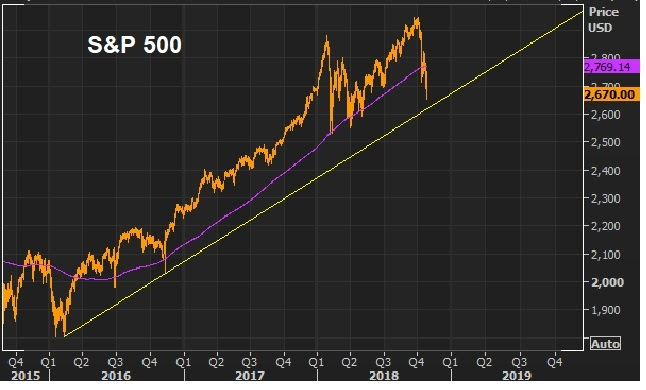January 11, 2022
Stocks continued the big bounce today into technical support.
Let’s take an updated look at the S&P 500 chart …

So, we had a 5.5% decline in this benchmark index to start the year, and now we have a sharp bounce of nearly 3% from this big technical trendline, which comes in from the election day lows of November 2020 (an important marker).
We heard from Jay Powell today, in his renomination hearings before the Senate. He did nothing to change the expectations on the Fed’s guidance on the rate path. Whether it be three or four hikes this year, we’ve just finished a year with around 10% nominal growth and over 5% inflation.
The coming year may be more of the same, and yet we have a market and Fed posturing and speculating over how close to 1% the Fed Funds rate might be by year end. That dynamic only adds fuel to the inflation and growth fire.
On that note, we’ve been watching three key spots that should be on the move with this policy outlook: bonds (down), gold (up) and the dollar (down).
Gold was up 1.25% today, making another run at this 1830-50 level. If that level gives way, the move in gold should accelerate. As you can see in the chart, we would get a breakout from this big corrective trend that comes down from the August 2020 all-time highs.
 On a related note (dollar down, commodities up), the dollar looks vulnerable to a breakdown technically …
On a related note (dollar down, commodities up), the dollar looks vulnerable to a breakdown technically …

March 25, 5:00 pm EST
There was a big technical break in the interest rate market on Friday. And the yield curve inverted.
What does it mean, and should we be concerned?
First, when people talk about the yield curve, they are typically talking about the yield on the 3-month Treasury bill versus the yield on the 10-year government bond. The latter should pay more, with the idea that money will cost more in the future (compensating for inflation and an “uncertainty about the future” premium).
When the 10-year is paying you less than you could earn holding a short term T-bill, the yield curve is said to be inverted. And this dynamic has predicted the past seven recessions. Why? Because it typically will be driven by a tighter credit environment, namely banks become less enthused about borrowing in the form of short term loans, to lend that money out in longer term loans. Money dries up. Unemployment goes up. Demand dries up. Economy dips.
With this in mind, today the 3-month treasury bill pays 2.44%. And the 10-year government bond pays 2.41%. The spread is negative which makes for an inverted yield curve.
Now, while an inverted yield curve has preceded recessions with a good record, we’ve also had inverted yield curves and no recession has followed.
What isn’t talked about much, is why the yield curve is inverting this time. It sort of spoils the drama to talk about the “why”. Unlike any other time in history, we have an interest market that has been explicitly manipulated by global central banks for the past decade (via global QE). And we have one major central bank (the Bank of Japan) remaining as a buyer of unlimited global assets (that includes U.S. 10 years, which pushes the 10-year yield lower).
Remember, the Bank of Japan’s policy of targeting their 10-year government bond yield at zero, means they will be a buyer of unlimited bonds to push JGB yields back toward zero (price goes up, yields go down). And when the tide of global rates is rising, pulling UP their yields, they will be a buyer of whatever they need to, to push things back down (and they’ve done just that).
What does that mean? It means, as the Fed has been walking its short-term benchmark rate higher, the “long-end” of the interest rate market (the 10-year yield) has been anchored by central bank buying – buying by all major central banks for the better part of a decade, and now led by the BOJ. That has kept a lid on the U.S. 10-year government bond yield, and global government bond yields in general.
With this at work, there have been few things better telegraphed than a U.S. yield curve inversion, as the Fed has told us for years that they will march their short-term rate beyond the anchored 10-year yield.
It’s often dangerous to say “this time is different”, but I think it’s fair to say that the past yield curve inversion/recession analyses don’t compare, when you have both components (the front-end and the long-end) completely controlled by global central banks for more than a decade. Join me
here to get my curated portfolio of 20 stocks that I think can do multiples of what broader stocks do, through the end of the year.

 On a related note (dollar down, commodities up), the dollar looks vulnerable to a breakdown technically …
On a related note (dollar down, commodities up), the dollar looks vulnerable to a breakdown technically …









